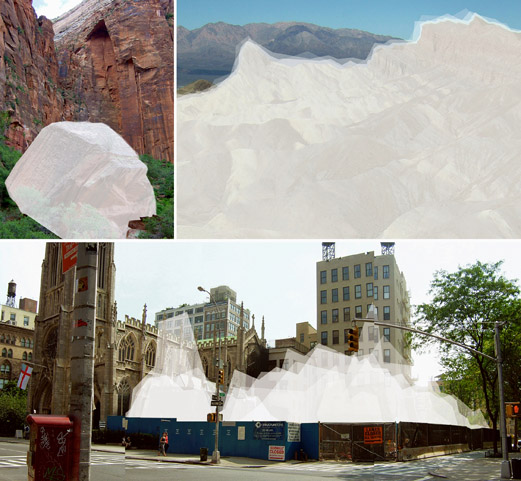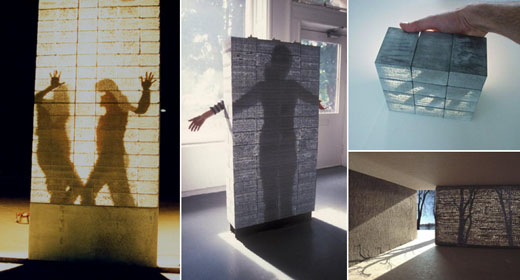 [Image: From Blend, where this post first appeared (translated into Dutch)].
[Image: From Blend, where this post first appeared (translated into Dutch)].
On a recent trip through California, it occurred to me that you could cover the entire state in an artificial glacier of translucent plastic, preserving its various landscapes.
For instance, you could pour several million gallons of liquid polymer into Death Valley, where that inland sea of sealant would slowly harden in the state’s dry heat. Soon, you find yourself slipping across semi-transparent slopes of white plastic, extending off to the desert horizon. These new plastic valleys would be easy to clean; you could even charge admission to anyone wishing to see them. Full-page advertisements featuring the white hills of California would immediately appear in European travel magazines: America – A Land in Plastic.
A plasticized landscape – glowing and geometric in the direct light of the sun – would, after all, serve a practical purpose: a layer of plastic could not only preserve but visually enhance natural rock formations, ensuring their stable existence for generations to come.
It would be both ecological and good for the economy.
 [Image: Abstract geology, by BLDGBLOG].
[Image: Abstract geology, by BLDGBLOG].
But then I realized: if you could laminate whole stretches of California, why not take a slightly different route and alter rock itself – transforming ancient stone into plastic? A new geology will arrive upon the surface of the earth: manmade, semi-transparent, abstract.
Think of it as the return of Dadaism: Marcel Duchamp meets the 21st-century packaging industry, via the planetary sciences. The Alps, readymade, sealed before your amazed eyes beneath a hard shield of pure white… You could roller-skate down Mt. Blanc. The winter Olympics would be forced to adapt immediately.
The idea, of course, is not without its industrial uses. Whole continents of plastic could be mined for building materials, sculpted into small, white briquettes then shipped halfway round the world to form weird new buildings in Manhattan. Masonry guilds could return to their medieval splendor, outdoing Vitruvius with internal spans four or five times larger than the most ambitious bridge ever constructed. Churches would function as their own stained-glass windows, bathing altarpieces in virginal white.
 [Images: Litracon bricks, via Transmaterial].
[Images: Litracon bricks, via Transmaterial].
Excitingly, the realization of this scenario might not be far off.
It was announced several years ago that light-transmitting concrete had been invented. Called Litracon, the new material is equal in strength to regular concrete, yet light passes through it. Litracon could well be used in the construction of future apartment blocks, football stadiums, even urban infrastructure – sewers, roads, and international motorways – all of which would suddenly cast no shadows.
 [Images: Litracon structures, via Litracon and many of our cities will fossilize. These fossil cities will be “a lot more robust than [fossils] of the dinosaurs.” In fact, the already buried, subterranean undersides of our modern cities, from Tube tunnels to nuclear bunkers, “will be hard to obliterate. They will be altered, to be sure, and it is fascinating to speculate about what will happen to our very own addition to nature’s store of rocks and minerals, given a hundred million years, a little heat, some pressure (the weight of a kilometre or two of overlying sediment) and the catalytic, corrosive effect of the underground fluids in which all of these structures will be bathed.”
[Images: Litracon structures, via Litracon and many of our cities will fossilize. These fossil cities will be “a lot more robust than [fossils] of the dinosaurs.” In fact, the already buried, subterranean undersides of our modern cities, from Tube tunnels to nuclear bunkers, “will be hard to obliterate. They will be altered, to be sure, and it is fascinating to speculate about what will happen to our very own addition to nature’s store of rocks and minerals, given a hundred million years, a little heat, some pressure (the weight of a kilometre or two of overlying sediment) and the catalytic, corrosive effect of the underground fluids in which all of these structures will be bathed.”
Plastics, for instance, “might behave like some of the long-chain organic molecules in fossil plant twigs and branches, or the collagen in the fossilized skeletons of some marine invertebrates.” A hundred thousand Evian bottles, then, may someday transform by compression into a new quartz: vast and subterranean veins of mineralized plastic.
In other words, plastics will, in fact, form a new geological layer upon the earth; plastics will be our future geology. It may take a hundred million years, but it will happen. Future Himalayan adventurers will stumble upon vast belts of plastic, compressed into ribbons between layers of bedrock. Volcanoes of the future will erupt, belching transparent magma – liquid plastic – rolling out in great sheets, boiling everything in their path. Unlucky animals will be entombed there, fossilizing slowly over another million years, till their hardened remains seem to hover inside plastic hillsides, like specimens in a resinous vitrine, an open-air museum. Future Darwins will open their sketchbooks, stunned…
Fantastically, given time and the right chemical composition, underground stratigraphies of white plastic will dissolve, forming caves. Blurred and colorless stalactites will hang over subterranean lakes in which blind fish swim, unaware of the milky walls and abstract rock formations hovering all around them. Steven Spielberg will direct his own version of Journey to the Center of the Earth, setting the film inside enormous tunnels of white plastic extending hundreds of thousands of feet into the planet. One by one, actors will lose consciousness and fall to the ground, passing out in contemplation of the apparently infinite abyss extending for miles beneath their feet… a hazy white glow coming from the very core of the planet.
(Note: Other BLDGBLOG material originally from Blend: Wreck-diving London and The Helicopter Archipelago – and more to come).
clearly you haven’t thought about the environmental damage of plastic production–i’m all for the speculative, but i think we have come to a point in time when proposals about the future oblivious to environment are over
Or, worse, I did think of it – but left it out, because I have a sense of humor. If you want the environment, read BLDGBLOG’s recent, long interview on climate change.
Meanwhile, you could fill the Grand Canyon with plastic, let it harden, remove the plastic in one piece… and then float it upside down across the world’s oceans.
An upside-down negative canyon at sea…
A scientist, researching new plastics, is discovered in his lab turned transluscent white and stony hard. His cat is, likewise transformed, stuck to his leg. An unlucky co-worker, known for her curiosity, reaches out to inspect and joins the sculpture in progress. A slight panic ensues and further touching is forbidden and the room is locked until a solution can be turned up. Everyone goes to the Hamptons for the weekend.
Upon return a strange sight meets the mournful colleagues of our genius of plastic. A chain of transluscent humans, each caught in mid-touch, emerges from a broken side window and forks repeatedly to form a tree of curiosity around the green and pleasant campus of the facility. A certain segment of the dendrite is made up of fully equipped firemen and policemen, now truly stony in their stoicism. their vehicles lined up on the road, lights flashing. A crowd of onlookers has been consumed because they stood too close together and one thought he was immune. The neighborhood cats stand away, having observed and learned, their tails lashing happily at the sight. The dogs have not been so lucky.
Over the course of several weeks, as the government considers whether the nuclear solution will be adequate and what group of outsiders caused this calamity, a cult forms. The followers join hands in long chains forming graceful curves or strange pyramids of humanity before the chosen member Touches.
As the sculpture grows past millions pockets of transclucent stiffies begin to appear in other parts of the world. TV broadcasts warn people to prepare for an end. A wave of plasticizing sweeps the planet, no one escaping. The cats lash their tails in silent amusement and return to the preferred routine of hunting grasshoppers and sleeping, far from the stony, and very quiet, crowds.
Brilliant post.
My own attempt attempt at an abstract geology might involve a thousand foot high scale model of Tora Bora made from litracon and built outside of Midland, Texas, the childhood home of #43. Which reminds me of an earlier post, why aren’t Leonardo or Brad doing this sort of thing with all their loot?
Years ago a macroproject idea for preserving the USA’s Grand Canyon was offered which involved filling that depression with…plastic peanuts like those used for padding the contents of shipped packages! And, of course, there is the macro-engineering idea to cover the Sahara with a tent. (SEE: Cathcart and Badescu, International Journal of Environmental Studies 61: 145-160 (2004) as well as (by the same authors)covering Earth’s surface with concrete and steel (International Journal of Global Energy Issues 25: 129-140 (2006).
I’ll match your plasticized landscape against MUTANT 59: THE PLASTIC-EATERS (Viking Press, NY, 1971,246 pages), by Kit Pedler (1927-1981) and Gerry Davis (1930-1991)any day! (They describe what happens with bio-technology’s results meet the real world’s infrastructure.)
There is nothing new under the sun. You are of course aware of Christo and Jeanne-Claude’s Wrapped Coast http://www.nga.gov/exhibitions/2002/christo/coast.shtm
done way back in 1969?